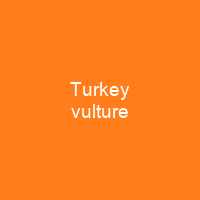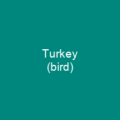The turkey vulture is one of three species in the genus Cathartes of the family Cathartidae. It inhabits a variety of open and semi-open areas, including subtropical forests, shrublands, pastures, and deserts. It is a scavenger and feeds almost exclusively on carrion. Each year it generally raises two chicks, which it feeds by regurgitation.
About Turkey vulture in brief

It roosts in large community groups. It uses thermals to move through the air, flapping its wings infrequently. The name ‘vulture’ is derived from the Latin word vulturus, meaning ‘tearer’, and is a reference to its feeding habits. The vulture was first formally described by Carl Linnaeus as Vultur aura in his 1758 10th edition of Systema Naturae, and characterised as ‘Vultur fuscogriseus, remigibus nigris, rostro albo’ It is not closely related to the Old World vultures of Europe, Africa, and Asia. The two groups strongly resemble each other because of convergent evolution; natural selection often leads to similar body plans in animals that adapt independently to the same conditions. Some earlier authorities suggested that the New World vULTures were more closelyrelated to storks. However, recent genetic studies indicate that neither New World nor Old World Vultures are close to falcons, nor are New WorldVultures close to stork. Both are basal members of the clade Afroaves, with Old Worldvultures comprising several groups within the family Accipitridae, also containing eagles, kites, and hawks.
You want to know more about Turkey vulture?
This page is based on the article Turkey vulture published in Wikipedia (as of Dec. 02, 2020) and was automatically summarized using artificial intelligence.







